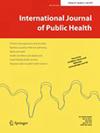埃塞俄比亚孕妇分娩准备和并发症准备做法的预测因素,系统回顾与元分析》(Predictors of Birth Preparedness and Complication Readiness Practices Among Pregnant Women in Ethiopia, a Systematic Review and Meta-Analysis)。
IF 2.6
3区 医学
Q2 PUBLIC, ENVIRONMENTAL & OCCUPATIONAL HEALTH
引用次数: 0
摘要
目标我们进行了这项研究,以确定与埃塞俄比亚孕妇分娩准备和并发症准备(BPCR)相关的因素。BPCR 是一种综合方法,有助于解决产科问题就医延迟的问题。使用带有 95% 置信区间的调整比值比 (AOR) 来确定因素。采用 I2 统计量、漏斗图和 Egger 检验来评估研究的异质性和发表偏倚。结果对 BPCR、孕期危险征兆、分娩和产后危险征兆的了解程度(AOR = 1.99,95% CI:1.51, 2.64;AOR = 1.55;95% CI:1.35, 1.80;AOR = 1.45;95% CI:1.27, 1.63;AOR = 1.4;95% CI:1.21, 1.63),居住地(AOR = 1.49;95% CI:1.32,1.68)、产前护理访问(AOR = 1.59;95% CI:1.43,1.78)、死胎史(AOR = 1.58;95% CI:1.36,1.86)和教育状况(AOR = 1.62:95% CI:1.45,1.78)分别与 BPCR 实践显著相关。本研究发现了一些可改变 BPCR 实践的因素。在医疗机构中整合咨询和扩大产前保健服务可改善 BPCR 实践。本文章由计算机程序翻译,如有差异,请以英文原文为准。
Predictors of Birth Preparedness and Complication Readiness Practices Among Pregnant Women in Ethiopia, a Systematic Review and Meta-Analysis.
Objectives
We conducted this review to identify factors associated with birth preparedness and complication readiness (BPCR) among pregnant women in Ethiopia. BPCR is a comprehensive approach that helps address delays in seeking care for obstetric problems.
Methods
PRISMA was followed and different databases were used to find studies. Adjusted Odds Ratio (AOR) with a 95% Confidence Interval was used to identify factors. The I2 statistic, funnel plot, and Egger test were used to assess the heterogeneity of studies and publication bias.
Results
Knowledge of BPCR, danger signs during pregnancy, labor, and postpartum (AOR = 1.99, 95% CI: 1.51, 2.64, AOR = 1.55; 95% CI: 1.35, 1.80; AOR = 1.45; 95% CI: 1.27, 1.63, and AOR = 1.4; 95% CI: 1.21, 1.63), respectively, residency (AOR = 1.49; 95% CI: 1.32, 1.68), antenatal care visit (AOR = 1.59; 95% CI: 1.43, 1.78), history of stillbirth (AOR = 1.58; 95% CI: 1.36, 1.86), and educational status (AOR = 1.62: 95% CI: 1.45, 1.78) were significantly associated with BPCR practice.
Conclusion
This study identified some modifiable factors in the practice of BPCR. Integrating counseling and expanding ANC services in health facilities may improve BPCR practice.
求助全文
通过发布文献求助,成功后即可免费获取论文全文。
去求助
来源期刊

International Journal of Public Health
医学-公共卫生、环境卫生与职业卫生
CiteScore
4.20
自引率
2.20%
发文量
269
审稿时长
12 months
期刊介绍:
The International Journal of Public Health publishes scientific articles relevant to global public health, from different countries and cultures, and assembles them into issues that raise awareness and understanding of public health problems and solutions. The Journal welcomes submissions of original research, critical and relevant reviews, methodological papers and manuscripts that emphasize theoretical content. IJPH sometimes publishes commentaries and opinions. Special issues highlight key areas of current research. The Editorial Board''s mission is to provide a thoughtful forum for contemporary issues and challenges in global public health research and practice.
 求助内容:
求助内容: 应助结果提醒方式:
应助结果提醒方式:


